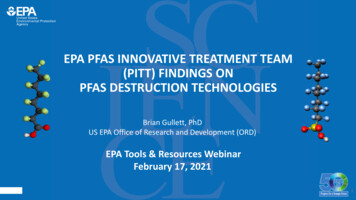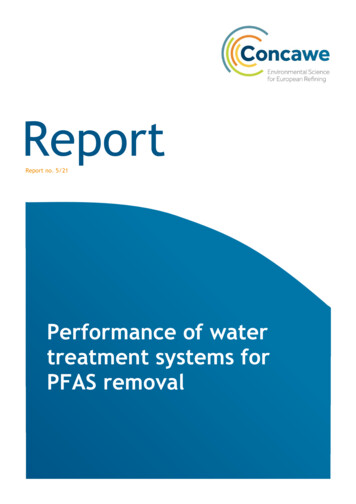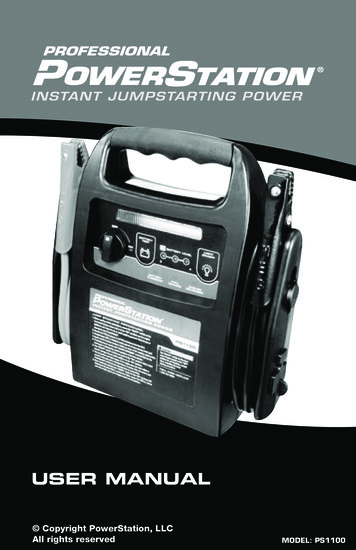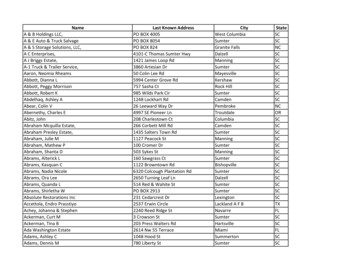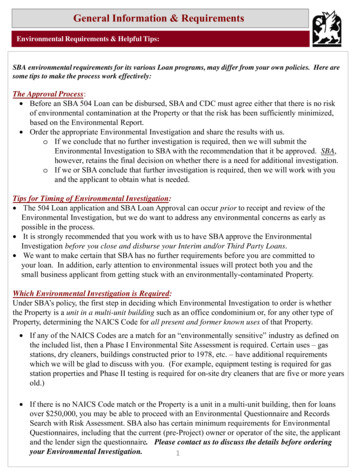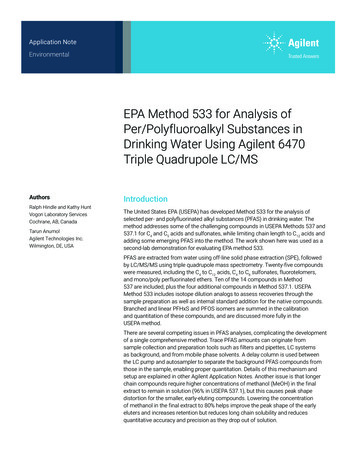
Transcription
Application NoteEnvironmentalEPA Method 533 for Analysis ofPer/Polyfluoroalkyl Substances inDrinking Water Using Agilent 6470Triple Quadrupole LC/MSAuthorsRalph Hindle and Kathy HuntVogon Laboratory ServicesCochrane, AB, CanadaTarun AnumolAgilent Technologies Inc.Wilmington, DE, USAIntroductionThe United States EPA (USEPA) has developed Method 533 for the analysis ofselected per- and polyfluorinated alkyl substances (PFAS) in drinking water. Themethod addresses some of the challenging compounds in USEPA Methods 537 and537.1 for C4 and C5 acids and sulfonates, while limiting chain length to C12 acids andadding some emerging PFAS into the method. The work shown here was used as asecond-lab demonstration for evaluating EPA method 533.PFAS are extracted from water using off-line solid phase extraction (SPE), followedby LC/MS/MS using triple quadrupole mass spectrometry. Twenty-five compoundswere measured, including the C4 to C12 acids, C4 to C8 sulfonates, fluorotelomers,and mono/poly perfluorinated ethers. Ten of the 14 compounds in Method537 are included, plus the four additional compounds in Method 537.1. USEPAMethod 533 includes isotope dilution analogs to assess recoveries through thesample preparation as well as internal standard addition for the native compounds.Branched and linear PFHxS and PFOS isomers are summed in the calibrationand quantitation of these compounds, and are discussed more fully in theUSEPA method.There are several competing issues in PFAS analyses, complicating the developmentof a single comprehensive method. Trace PFAS amounts can originate fromsample collection and preparation tools such as filters and pipettes, LC systemsas background, and from mobile phase solvents. A delay column is used betweenthe LC pump and autosampler to separate the background PFAS compounds fromthose in the sample, enabling proper quantitation. Details of this mechanism andsetup are explained in other Agilent Application Notes. Another issue is that longerchain compounds require higher concentrations of methanol (MeOH) in the finalextract to remain in solution (96% in USEPA 537.1), but this causes peak shapedistortion for the smaller, early-eluting compounds. Lowering the concentrationof methanol in the final extract to 80% helps improve the peak shape of the earlyeluters and increases retention but reduces long chain solubility and reducesquantitative accuracy and precision as they drop out of solution.
This Application Note providesresults obtained in a second labdemonstration for USEPA Method 533,using an Agilent 6470 triple quadrupoleLC/MS/MS.MS instrument conditionsParameterValueAgilent 6470 TripleQuadrupole MS/MS withAgilent Jet Stream ESIsourceMSLC instrument conditionsParameterValueLCAgilent 1260 series Infinity binary pump, G1367E Infinity ALS, G1316A Infinity thermostatedcolumn compartmentAnalytical ColumnAgilent ZORBAX Eclipse Plus C18, 3 50 mm; 1.8 µm (p/n 959757-302)Delay ColumnAgilent ZORBAX SB-C18, 4.6 50 mm, 3.5 µm (p/n 835975-902)Column Temperature50 CInjection Volume10 uLMobile PhaseA) 20 mM Ammonium acetate in water (LC grade)B) MeOH (LC grade)Gradient Flow Rate0.4 mL/minGradientTime (min)0.00.53.016.018.020.0Source Parameters%B5540808095Gas Temperature230 CGas Flow4 L/minNebulizer20 psiSheath Gas Temperature375 CStop Time20.0 minutesSheath Gas Flow12 L/minPost Time6 minutesCapillary Voltage (Neg)2,500 VNozzle Voltage (Neg)0VdMRM transitionsThe method used dynamic multiplereaction monitoring (dMRM), and wasrun in electrospray negative mode usingan Agilent 6470 LC/MS/MS.All compound parameters includingprecursor ion, product ion, fragmentorvoltages, and collision energies wereoptimized for each compound withAgilent Optimizer Software (Table 1).Refer to Application Note 5991-7951 formore details. The cell accelerator voltagewas selected as 2 V for all compounds.Note: It is highly recommended to run at least one blank injection at the start of the worklist to remove any built‑upcontaminants from the system.Table 1. Compound parameters.CompoundPrecursor IonProduct IonRet Time (min)Fragmentor 1313131313C9-PFNA2Collision Energy (V)13472.0427.014.686644:2FTS327.0306.99.1812520
Table 1. Compound parameters, continued.Precursor IonProduct IonRet Time (min)Fragmentor (V)Collision Energy UnA563.0519.017.12735PFUnA563.0269.017.12100203
Preparation of calibration standardsThe high calibrator was prepared bydilution of a 500 ng/mL analyte dilutionstandard containing all analytes ofinterest. 1:4 serial dilutions of the highcalibrator were prepared in 80% MeOHfor subsequent calibrators. Isotopedilution standard and internal standardwere added before analysis. 104Acids6543215ExtractionWater samples, 250 mL, were fortifiedwith isotope dilution analogues, andwere extracted using weak anionexchange cartridges according to EPAMethod 533. Samples were eluted withan ammonium hydroxide/MeOH solutionand concentrated to dryness beforereconstituting with 80% MeOH. Internalstandard was added before analysis.789101112131415161718 104FTS0.90.80.70.60.50.40.30.20.1ChromatographyThe chromatograms shown in Figure 1are from a 1.5 ng/mL (in vial) calibratorseparated by compound group.68.59.09.510.0 10.5 11.0 11.5 12.0 12.5 13.0 13.5 14.0 14.5 15.0 15.5 16.0 16.5 3Figure 1. Chromatograms separated by compound group.41415161718
Performance: precision and accuracyThe precision and accuracy of themethod was evaluated by fortifyingfive replicates of reagent andmunicipal‑treated tap water samplesat 48 ng/L.Precision and accuracy were within EPArequirements. All PFAS compoundshad recoveries between 87 and 103% inreagent and tap water, with a maximumof 5% RSD in reagent water and 12% RSDin tap water. Precision and accuracywere within EPA requirements as notedin USEPA method 533.Table 2. Precision and accuracy of the method.RTCompoundGroupReagent WaterRecoveryReagent Water%RSDTap WaterRecoveryTap .66sulfonate98%2%92%12%Compound5
Performance: low system backgroundand LCMRLEvidence of low system background isdemonstrated by injecting a laboratoryreagent blank (LRB) immediatelyfollowing the high calibrator andevaluating the concentration of eachanalyte in the LRB. The LRB is an aliquotof reagent water fortified with the isotopedilution analogues and processed as afield sample. LRBs are used to determineif method analytes are introduced fromthe lab equipment, reagents, glassware,or extraction apparatus. Trace levels ofa few PFAS were seen in the LRB, whichcould be due to contamination fromsample preparation, etc. The instrumentblanks that were 80% MeOH did notshow any PFAS contamination, indicatingthat the LC/MS/MS was PFAS-free.The lowest concentration minimumreporting limit (LCMRL) was determinedby spiking progressively lowerconcentrations of the analytes inreagent water and extracting such thatthe recovery was still in the range of50 to 150%.Table 3. Low system background and LCMRL.CompoundRTCompoundGroupInstrument Blank(ng/L)LRB Concentration(ng/L)LCMRL(ng/L)EPA 533LCMRL d––1.83.7PFHpA11.36acid–0.384.2* 1.411Cl-PF3OUdS17.66sulfonate–0.010.671.6 Single-lab LCMRLs determined during method development by EPA and listed in Table 7 of EPA method 533.* One high outlier point was observed for PFHpA in one of the four spikes at 1.6 ng/L. All other compounds inthose spikes had recoveries within the accuracy specifications. Because all compounds are spiked using amixture containing all compounds, and LRB values were low in that batch, the high PFHpA result appears tobe from the SPE used for that sample. Instrument sensitivity for PFHpA is much lower, as shown in Figure 2A.The LCMRL without the outlier is shown in the brackets.6
ABCFigure 2. A, B, and C show chromatograms for acids, FTSs, and sulfonates, respectively, at the calibration concentration of 0.003 ng/mL in the vial (0.05 ng/mL forHFPO-DA).7
Background chromatographyDouble blanks do not contain internalstandards (ISTDs), isotope dilutionanalogs (IDAs), or target compounds, nordo they get processed through sampleextraction steps. They are simply solventblanks to demonstrate backgroundlevels in the LC/MS/MS system. Blank injections are unextracted solvent blanksthat contain both ISTDs and IDAs.The chromatograms in Figure 3 are onthe same scale, indicating the absence ofPFAS in the LC/MS/MS system. 103Double Blank (System Background) – 80% 61718 103Blank (80% MeOH with ISTDs and Isotope Dilution Analogs) - 131415161718 103LRB – Lab Reagent Blank carried through extraction procedure1.71.51.31.10.90.70.50.30.14 rator (0.05 ng/mL)1.71.51.31.10.90.70.50.30.145678Figure 3. Background chromatography.8
ConclusionThe EPA method allows flexibility in thechoice of LC columns, LC conditions,and MS conditions. The Agilent ZORBAXEclipse Plus C18 column used for thiswork provided baseline resolutionfor all compounds within each class,with minimal RT overlap amongall compounds.Precision and accuracy were within EPArequirements. Recoveries were between87 and 103% for all PFAS compounds inreagent and tap water, with a maximumof 5% RSD in reagent water and 12% RSDin tap water. LCMRL values were all lowerthan EPA values listed in EPA 533 exceptfor PFHpA, where determined LCMRLwas slightly higher due to inclusion ofan outlier in one of the four spikes thatwas attributed to the SPE cartridgefor that sample. However, instrumentsensitivity noted during testing wasmuch higher than needed by the method.Of the 25 compounds in the method,22 LCMRLs were determined to be at orbelow 1 ng/mL. The lowest LCMRL inthe EPA method was 1.8 ng/L. This workhas been used as a second-lab validationfor the creation of EPA method 533, anddata have been acknowledged in theofficial method.9
www.agilent.com/chemThis information is subject to change without notice. Agilent Technologies, Inc. 2020Printed in the USA, January 17, 20205994-1628ENDE.3925347222
Cochrane, AB, Canada Tarun Anumol Agilent Technologies Inc. Wilmington, DE, USA Introduction The United States EPA (USEPA) has developed Method 533 for the analysis of selected per- and polyfluorinated alkyl substances (PFAS) in drinking water. The method addresses some of the challenging compounds in USEPA Methods 537 and 537.1 for C 4 and C 5
